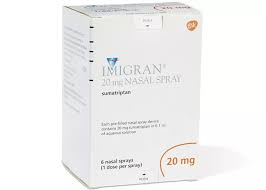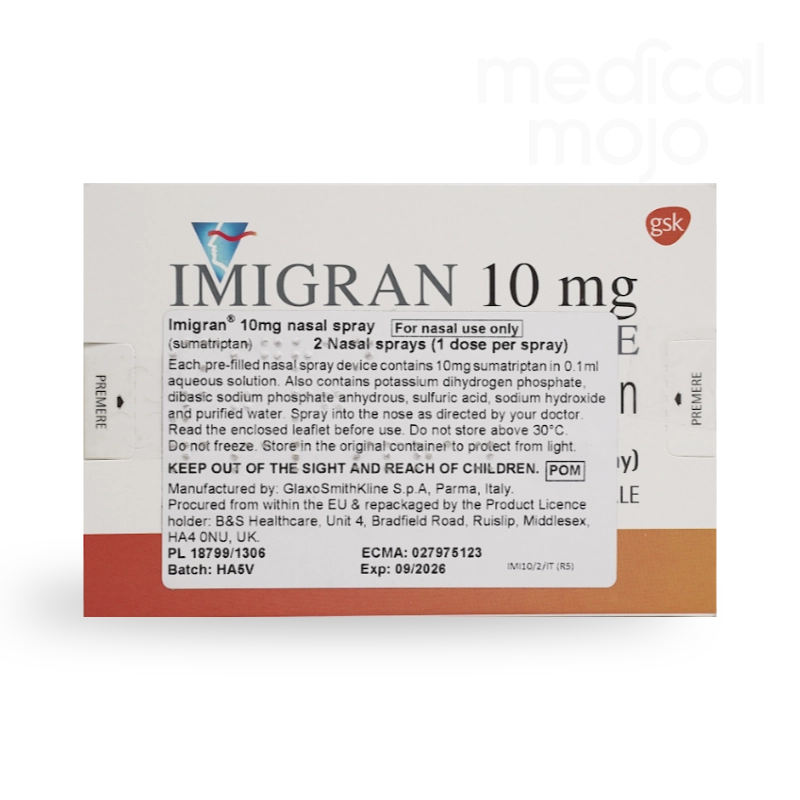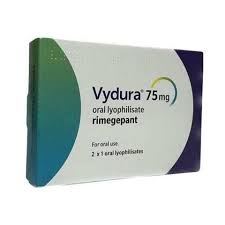Migraine
Tired of migraines ruining your day? Take back control with our range of effective treatments
Stop migraines in their tracks with rapid and clinically proven treatment options.
Beat migraines before they start with our range of preventative solutions.
Find the right migraine treatment for you
View All ProductsWhat you should know about migraine treatments
A migraine is a neurological condition characterized by intense, throbbing headaches often accompanied by nausea, vomiting, and sensitivity to light and sound. Unlike regular headaches, migraines can last for hours or even days and are typically more debilitating.
Migraine triggers vary from person to person but can include stress, certain foods and drinks (like chocolate, cheese, caffeine, and alcohol), hormonal changes, lack of sleep, dehydration, bright lights, and strong smells. Keeping a migraine diary can help identify your specific triggers.
Common symptoms include a severe, throbbing headache on one side of the head, nausea, vomiting, sensitivity to light and sound, and visual disturbances such as flashing lights or blind spots (known as aura).
Migraines are diagnosed based on your medical history, the pattern of your headaches, and your symptoms. Your doctor may recommend keeping a headache diary and might conduct tests to rule out other conditions if necessary.
Vydura is the brand name for a medication known as rimegepant, which is used to treat migraines. Rimegepant belongs to a class of drugs called CGRP (calcitonin gene-related peptide) receptor antagonists. It works by blocking the activity of CGRP, a substance in the brain that is believed to play a key role in causing migraine headaches.
Vydura can be used both as an acute treatment for relieving migraine symptoms once they start and as a preventive treatment to reduce the frequency of migraine attacks. It is taken orally, usually in the form of a dissolvable tablet, which makes it convenient for use during a migraine attack.
The medication is particularly beneficial for people who do not respond well to traditional migraine treatments like triptans or for those who cannot take such medications due to side effects or other health conditions.
As with any medication, it is important to use Vydura as prescribed by a healthcare professional and to be aware of potential side effects, which can include nausea, indigestion, or allergic reactions.
You should seek medical attention if you experience sudden, severe headaches, changes in your migraine pattern, headaches with neurological symptoms (like vision changes or numbness), or headaches following a head injury. These could be signs of a more serious condition.
While there is no cure for migraines, they can often be managed and sometimes prevented with a combination of medication, lifestyle changes, and avoiding known triggers. Preventive medications may be prescribed for those with frequent or severe migraines.
Yes, lifestyle changes such as maintaining a regular sleep schedule, staying hydrated, eating balanced meals, managing stress, and avoiding known triggers can help reduce the frequency and severity of migraines. Regular exercise and relaxation techniques like yoga or meditation may also be beneficial.
Additional information
Migraine treatment and management at Medical Mojo
Migraines are more than just headaches; they are debilitating neurological conditions that can cause severe pain, nausea, and sensitivity to light and sound. These symptoms can make it difficult to carry out daily activities, impacting your overall quality of life. At Medical Mojo, we understand the challenges of living with migraines and are committed to helping you find the right treatments to manage your symptoms and regain control.
What is a migraine?
A migraine is a complex condition characterized by intense headaches, often accompanied by nausea, vomiting, and heightened sensitivity to light and sound. Migraines are more common in women, affecting about 1 in 5, compared to 1 in 15 men. Although they can begin in early adulthood, the frequency and severity of migraines can change over time, sometimes easing as one ages. This condition can be highly disruptive, with symptoms severe enough to hinder daily activities and reduce quality of life.
Migraines vary greatly from person to person. Some people experience migraines several times a week, with symptoms lasting for days, while others might have milder, less frequent episodes. Regardless of the frequency, migraines can significantly impact your life, making it crucial to find effective treatment and preventive strategies.
There are two primary types of migraines:
- Migraine with aura: Previously known as a ‘classic migraine,’ this type is marked by sensory disturbances, or ‘aura,’ that occur before the headache begins. Individuals may experience visual disruptions like blind spots or flashing lights, as well as sensations of numbness, tingling, or other neurological symptoms. These aura symptoms typically manifest within an hour before the migraine attack.
- Migraine without aura: The most common form of migraine, previously referred to as ‘common migraine’ or ‘hemicrania simplex,’ occurs without the preceding sensory disturbances. Individuals with this type experience the migraine attack without any warning signs.
In addition to these, there are other less common types of migraines:
- Chronic migraine: Characterised by migraine symptoms occurring at least 15 days per month.
- Migraine with brainstem aura: A rare form that includes neurological symptoms such as slurred speech and tingling sensations.
- Vestibular migraine: Associated with balance issues and dizziness.
- Hemiplegic migraine: A rare type involving temporary weakness on one side of the body.
Understanding the type of migraine you experience can help you select the most effective treatment and management strategies.
Causes and triggers of migraines
The exact cause of migraines is still not fully understood, but they are believed to result from abnormal brain activity that affects nerve signals, chemical balances, and blood vessels in the brain. Genetics may play a role, making certain individuals more susceptible to migraines after exposure to specific triggers.
Common migraine triggers include:
- Emotional triggers: Stress, anxiety, excitement, and depression.
- Physical triggers: Tiredness, poor posture, neck or shoulder tension, and low blood sugar.
- Dietary triggers: Irregular meals, dehydration, caffeine, alcohol, and certain foods like chocolate or cheese.
- Environmental triggers: Bright or flickering lights, strong smells, loud noises, and weather changes.
- Hormonal triggers: Hormonal fluctuations, especially during menstruation.
What are the symptoms of a migraine?
Migraines typically progress through five stages, each with distinct symptoms. However, not everyone experiences all stages, and symptoms can vary between individuals.
Premonitory stage (prodrome):
This early phase occurs up to 24 hours before a migraine and serves as a warning sign. Symptoms may include:
- Fatigue
- Food cravings
- Mood changes (high or low)
- Thirst
- Neck stiffness
Aura stage
For those with migraines accompanied by aura, this stage occurs up to 60 minutes before the headache. Aura symptoms, which result from abnormal neural activity, can include:
- Visual changes (e.g., spots, sparkles, zigzag lines)
- Numbness or tingling
- Weakness
- Dizziness or poor balance
- Speech or hearing changes
Headache/main attack stage
This stage is characterized by severe, throbbing head pain, often on one side of the head but can spread across the entire head. Other symptoms may include:
- Nausea and vomiting
- Sensitivity to light, sound, smell, and movement
Resolution stage
This phase marks the gradual end of the migraine, which may take several hours to a few days. The attack may end suddenly after certain activities like vomiting or sleeping.
Recovery/postdrome stage
In the final stage, many feel drained and exhausted, though some may experience an energy boost. This recovery period can last for days after the initial migraine attack.
Understanding these stages can help in managing and treating migraines more effectively.
Diagnosing migraines
Diagnosing migraines typically involves a thorough assessment by your GP, who will evaluate your headache patterns, symptoms, and response to treatments. Keeping a migraine diary can be helpful in tracking potential triggers, symptoms, and the effectiveness of any treatments you try.
Treatment options for migraines
While there is no cure for migraines, various treatments can help manage symptoms and reduce the frequency of attacks. Treatment options include:
- Painkillers: Over-the-counter medications like paracetamol, ibuprofen, or aspirin can be effective if taken early in the migraine attack. Stronger painkillers containing codeine, such as Solpadeine or Nurofen Plus, may be necessary for more severe pain.
- Triptans: If standard painkillers are not effective, Triptans (such as Sumatriptan, Rizatriptan, or Almotriptan) can be prescribed. These medications work by narrowing blood vessels in the brain to alleviate the pain.The most commonly prescribed medications for migraines are from a group known as triptans (5-HT1 agonists), which include options like Sumatriptan (Imigran), Zolmitriptan (Zomig), and Almotriptan (Almirall). These medications work by narrowing the blood vessels in the brain and targeting the trigeminal nerve, both of which play a role in triggering migraines. While some triptan tablets are available over the counter, most require a prescription. Triptans are also available as nasal sprays and injections for those who need alternative methods of administration.
- Anti-sickness treatments: Anti-sickness treatments like Buccastem are commonly used to alleviate nausea and vomiting associated with migraine attacks. Similar to painkillers, these treatments are most effective when taken early in the onset of symptoms, especially if you typically experience nausea during a migraine. The sooner you take them, the better they can manage the symptoms.Buccastem is a preferred option for treating migraine-related nausea and vomiting. It comes in a buccal tablet form, which dissolves between the lip and gum, eliminating the need to swallow a pill when you’re feeling nauseous. This method allows the medication to be absorbed quickly through the gums, providing faster relief.
Preventing migraines
Prevention is key for those who experience frequent migraines. Identifying and avoiding triggers can significantly reduce the occurrence of migraines. For individuals with more than five migraine days per month, preventive medications such as beta-blockers, anticonvulsants, or CGRP monoclonal antibodies might be recommended by your GP.
Recently, a new class of medication called CGRP mAbs (calcitonin gene-related peptide monoclonal antibodies) has been developed specifically for migraine prevention. These medications work by targeting CGRP antibodies, which are believed to play a role in triggering migraines.
When to seek immediate medical attention
Red flags for migraines, also known as “migraine red flags,” are warning signs that may indicate a more serious underlying condition requiring immediate medical attention. If you experience any of the following symptoms, it’s crucial to seek medical help promptly:
- Sudden, severe headache: A sudden and extremely severe headache, often described as the “worst headache of your life,” could indicate a serious condition like a brain aneurysm or stroke.
- New or different headache pattern: If you experience a sudden change in the pattern, frequency, or intensity of your headaches, especially if you’re over the age of 50, it may be a sign of an underlying issue.
- Neurological symptoms: If you have neurological symptoms such as double vision, slurred speech, weakness or numbness on one side of the body, difficulty walking, or confusion, it could indicate a stroke or other neurological condition.
- Headache with fever, neck stiffness, or rash: These symptoms could indicate meningitis or another serious infection, especially if they accompany a headache.
- Headache after a head injury: A headache that develops after a head injury, particularly if it worsens over time, could indicate a concussion or other serious injury.
- Persistent or worsening Headache: If your headache persists for more than 72 hours, worsens over time, or is resistant to treatment, it could be a sign of a more serious condition.
- Headache with seizures: The occurrence of seizures alongside a headache is a red flag that warrants immediate medical evaluation.
- Changes in vision: Experiencing sudden or severe changes in vision, such as partial or complete loss of vision, could indicate a serious problem like a stroke or retinal issue.
- Headache with fainting or loss of consciousness: Fainting or loss of consciousness in conjunction with a headache is a serious red flag and requires urgent medical attention.
If you or someone you know experiences any of these red flags, it is important to seek immediate medical care to rule out potentially life-threatening conditions.
Buy migraine treatments online
At MedicalMojo.co.uk, you can conveniently order migraine medications such as Almotriptan, Zolmitriptan, Sumatriptan and the recently released Vydura online. Simply fill out a brief medical questionnaire, and our registered doctors will assess your suitability for the medication. If approved, your order will be delivered to your doorstep with free next-day delivery.
Take control of your migraines
Don’t let migraines control your life. With the right treatment and preventive measures, you can manage your symptoms effectively and enjoy a better quality of life. Visit MedicalMojo.co.uk today to explore your options and start your journey towards migraine relief.
BSc Pharmacy, Independent Prescriber, PgDip Endocrinology, MSc Endocrinology, PgDip Infectious Diseases
Superintendant Pharmacist, Independent Prescriber
MPharm, Independent Prescriber. Registered cupping therapist.
Independent prescriber






